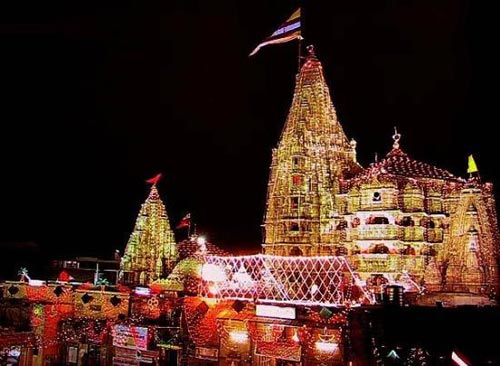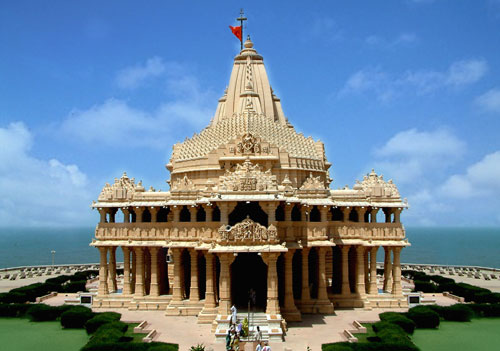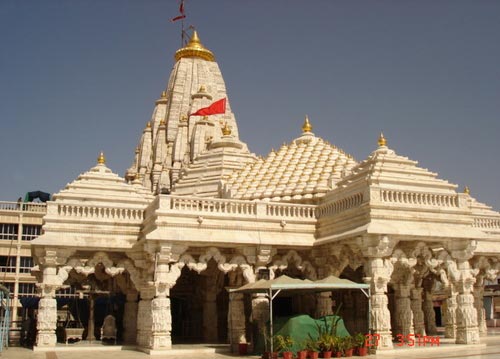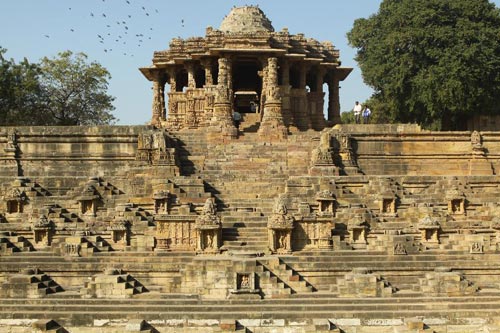|
|
|
|
|
|
|
|
Visit India |
|
|
|
|
|
|
|
|
|
Akshardham
Temple |
|
 Akshardham is majestic, intricately carved stone structure which stands amid sprawling gardens set in a 23-acre plot at Gandhinagar (Gandhinagar district). It is built in 6000
tones of pink sandstone and not a bit of steel has been used. The temple is 108 ft in height, 240 ft in length and 131 ft in width. A point worth noting is that this modern monument to Hinduism was built as per the injunctions of Vastu Shastra.The monument enshrining the seven foot high, gold-leafed Murti (idol) of Lord Swaminarayan is the focal point of the complex.
Akshardham is majestic, intricately carved stone structure which stands amid sprawling gardens set in a 23-acre plot at Gandhinagar (Gandhinagar district). It is built in 6000
tones of pink sandstone and not a bit of steel has been used. The temple is 108 ft in height, 240 ft in length and 131 ft in width. A point worth noting is that this modern monument to Hinduism was built as per the injunctions of Vastu Shastra.The monument enshrining the seven foot high, gold-leafed Murti (idol) of Lord Swaminarayan is the focal point of the complex.
The monument
stands on 7
sculpted
pillars, 210
single-piece
stone beams, 57
window grills,
eight ornate
zarokhas, etc.
The sanctum
sanctorum
contains the 1.2
ton gold-plated
idol of Lord
Swaminarayan,
the founder of
the sect that
bears his
name, shown in a
sitting posture
with his right
hand raised in
abhay mudra. He
is flanked by
Swami
Gunatitanand on
his right and
Swami Gopalanand
Swami on his
left. Both of
them were his
disciples. Swami
Gunatitanand is
called
Swaminarayan's
Akshardham, the
eternal abode.
According to the
Swaminarayan
philosophy
whenever Lord
Swaminarayan
incarnates on
this planet he
brings with him
his Akshardham. |
|
| Dwarkadhish Temple |
|
 Dwarka
which was known
as Suvarna
Dwarka (The
Golden Dwarka)
had been very
prosperous and
hence got the
name. The
Dwarkadhish
temple honours
Krishna Bhagwan
and attracts
thousands of
pilgrims from
different parts
of the country.
The Dwarka of
Krishna's time
lies submerged
under the
Arabian Sea.
Tradition has
itthat Krishna's
residence was at
Bet Dwarka, a
few kms from the
mainland Dwarka. Dwarka
which was known
as Suvarna
Dwarka (The
Golden Dwarka)
had been very
prosperous and
hence got the
name. The
Dwarkadhish
temple honours
Krishna Bhagwan
and attracts
thousands of
pilgrims from
different parts
of the country.
The Dwarka of
Krishna's time
lies submerged
under the
Arabian Sea.
Tradition has
itthat Krishna's
residence was at
Bet Dwarka, a
few kms from the
mainland Dwarka.
Dwaraka is known all over the world for the Dwarkadhish temple, the 'Lord of Dwaraka'. This temple is also known as the Jagat Mandir or the temple of the world. This temple was constructed over 1400 years ago and houses the image of Lord Krishna. This temple is one of the most famous pilgrimage place for the Hindus and attracts pilgrims from all over the world. This temple is magnificently built on the traditional lines and has five floors supported by 60 columns.
The temple is profusely carved from the base to the pinnacle. The temple is Dwarkadhish Temple Dwaraka
built of sandstone. The interior is simple while the exterior is covered with elaborate carvings. Some of the major festivals of Janmashtami and Navratri are celebrated with great enthusiasm and rejoicing in the Dwarka. After visiting the main temple, some of the devotees visit the Shankhoddhar Beyt or Beyt Dwaraka. |
|
| Somnath Temple |
|
 The Somnath
Temple
located
in the Prabhas
Kshetra near
Veraval in
Saurashtra, on
the western
coast of
Gujarat, India,
is one of the
twelve
Jyotirlinga
shrines of the
god Shiva.
Somnath means
"The Protector
of (the) Moon
god". The
Somnath Temple
is known as "the
Shrine Eternal",
having been
destroyed many
times by Islamic
kings and
rulers.
The Somnath
Temple
located
in the Prabhas
Kshetra near
Veraval in
Saurashtra, on
the western
coast of
Gujarat, India,
is one of the
twelve
Jyotirlinga
shrines of the
god Shiva.
Somnath means
"The Protector
of (the) Moon
god". The
Somnath Temple
is known as "the
Shrine Eternal",
having been
destroyed many
times by Islamic
kings and
rulers.
The Someshwar Mahadev temple stands tall among the temples of India. The construction of the present temple in Junagadh district began in 1950. It is the seventh temple built to commemorate the glory of Lord Somnath who was known as BhAiraveshwar
in the Satya Yug, Shravanikeshwar in Treta Yug and Shrigaleshwar in DwaparYug.
According to legend, Soma, the moon God built the temple in gold, Ravan in silver, Krishna in wood and king Bhimdev of Anhilwad in stone. Soma constructed the temple as a gesture after Lord Shiva cured him of his illness. This illness was caused by his father-in-law Daksha Prajapati's curse.
|
|
| Ambaji Temple |
|
 Ambaji is an important temple town with millions of devotees visiting the Ambaji temple every year. It is one of the 51 Shaktipeeths. The full moon of Bhadrapad is one of the four most important festival days of the year, when farmers and agriculturists come to Ambaji. Ambaji is an important temple town with millions of devotees visiting the Ambaji temple every year. It is one of the 51 Shaktipeeths. The full moon of Bhadrapad is one of the four most important festival days of the year, when farmers and agriculturists come to Ambaji.
The Ambaji shrine is the principal shrine of the goddess in Gujarat and its origins are still unknown. The original seat of Ambaji mata is on gabbar hilltop in the town. The Temple of Ambaji is recognized as one of the original Shakti Pithas (religious texts) where, according to the ancient Scriptures, the heart of the goddess Ambaji fell to earth when her body was dismembered. A triangular Vishwa Yantra, inscribed with figures and the syllable 'Shree' in the centre, represents the deity. There is no idol, which in fact testifies the temple's antiquity. Idol worship became popular much later.
Pilgrims from
all regions in
Gujarat visit
Ambaji chanting
their way ‘Bol
mari Ambe, jai
jai Ambe.’ The
ll-km-long
Trishulia Ghat
route towards
Ambaji town is
decorated with
festoons, flags
and colorful
lights. On the
way, all the
roads leading to
Ambaji from
different
regions are
found with
walking
pilgrims,
singing and
dancing with
chants of Amba
mata. On the way
are refreshment
stalls and rest
houses set up by
donators. |
|
|
Sun Temple
|
|
 The 11th century Sun temple is situated on a knoll in Modhera, about 106 kms. north west of Ahmedabad. The Sun Temple was built by King Bhimdev I in 1026-27 AD, two centuries before the Sun Temple at Konark. This temple is one of the finest Hindu temples in Gujarat, built by the great Solanki dynasty. This temple and the Konark Sun temple in Orissa are very similar. This similarity is that this temple was also designed in such a way so as to let the sun shine on the image of Surya, at the time of dawn.
The 11th century Sun temple is situated on a knoll in Modhera, about 106 kms. north west of Ahmedabad. The Sun Temple was built by King Bhimdev I in 1026-27 AD, two centuries before the Sun Temple at Konark. This temple is one of the finest Hindu temples in Gujarat, built by the great Solanki dynasty. This temple and the Konark Sun temple in Orissa are very similar. This similarity is that this temple was also designed in such a way so as to let the sun shine on the image of Surya, at the time of dawn.
The main hall and shrine are reached through a complex, pillared pavilion. Beautiful columns and magnificent carvings decorate the hall. The exterior of Modhera Sun Temple
the temple is intricately and delicately carved, showing demons and evolving gods. Despite its partial destruction by Mahmud of Ghazni and by subsequent earthquakes, it remains an outstanding monument, set against the backdrop of the barren landscape. Fifty two intricately carved pillars depict scenes from the Ramayana and Mahabharata. Unlike the exterior, the interior hall is plain with 12 niches representing the Surya's different monthly manifestations. |
|
|
Girnar Temple |
|
 Mt.Girnar (Junagadh district) is a sacred hill both to the Hindus and Jains. The Jains call it Mt. Neminath. According to traditional history, Siddhas have used it as a retreat to undertake tapasya since ancient times. The 3660 feet hill is connected with Lord Krishna. When Kalayavan, apparently a warrior of foreign origin, was chasing him, the Lord got the better of the powerful adversary in a curious way. Mt.Girnar (Junagadh district) is a sacred hill both to the Hindus and Jains. The Jains call it Mt. Neminath. According to traditional history, Siddhas have used it as a retreat to undertake tapasya since ancient times. The 3660 feet hill is connected with Lord Krishna. When Kalayavan, apparently a warrior of foreign origin, was chasing him, the Lord got the better of the powerful adversary in a curious way.
Raja Muchkund was sleeping in one of the caves of Raivatachal mountain (the ancient name for Girnar) He was taking rest after fighting on behalf of the gods. After his exertions Muchkund had only one desire rest and repose. He got a boon that whoever disturbed his sleep would be reduced to ashes when he opened his eyes.
This boon Krishna knew. What better way to get rid of Kalyavan. So he pretended as if he was running away from Kalyavan and led him to the cave where the king was sleeping.
Krishna covered Muchkund with his upper cloth. Kalyavan after the long chase mistook the sleeping figure for Krishna and woke him up and was reduced to ashes.Girnar was known by different names at different periods-Ujjayant, Manipur, Chandraketupur, Raivat Nagar, Puratanpur, Girivar and Girnar. |
|
|
|
|
Scroll
|
|
|
|
 |
|
|
